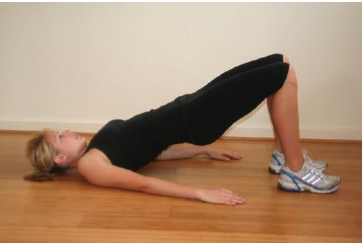ABOUT THE OPERATION
The aim of your operation is to reconstruct the Anterior Cruciate Ligament (ACL) to restore knee joint stability. A graft, consisting of your hamstring tendon, is used to replace the damaged ligament. The graft is obtained via incisions at the front of your knee. The remainder of the surgery is done arthroscopically, which means that most of the surgery has been done inside the knee with the aid of a telescope-like instrument, and without actually opening/cutting the knee joint capsule. This results in less pain and scarring within the knee post-operatively and ultimately a quicker recovery. Because the hamstring tendon has been used for the graft it is normal for the hamstring to feel sore for up to 6 weeks post-op. If a synthetic graft (lars) is used this allows for a more accelerated rehabilitation program.
The graft is fed through a tunnel drilled into the tibia (shin bone), across the knee joint and then into the femur (thigh bone). The graft is fixed at each end with screws and is therefore initially very strong, allowing early movement and weight bearing on the leg.
Because the ACL graft is a free graft with no blood vessels, time is needed for the graft to establish its own blood supply. The graft is strong immediately post-op, but loses strength during the first 6-8 weeks, and is at its weakest 6 weeks post-op. It is vulnerable at this time as the knee feels strong, but the graft is only beginning to establish its new blood supply. The graft does not have good blood supply until at least 10 weeks post-op. At 12 months post-op, the graft is 92% as strong as the original ACL, and this is as much strength as it develops.

AFTER THE OPERATION
The main aim of the first 2 weeks is to keep swelling and pain to a minimum and to maintain some muscle tone and flexibility. This can be achieved in the following ways:
- Apply ice to the knee for 20 minutes after each set of exercises, i.e. 3-4 times per day.
- When applying ice, keep the leg in elevation. Sitting with your leg up on a stool is not adequate, you need to have the whole leg above the level of your heart. For example, lie on floor/bed with foot up on chair/pillows etc.
- There should be little or no pain associated with the exercises. Ease off on the exercises if they cause increased pain or swelling.
- Do not rest with a pillow crossways under your knee. It should rest completely straight.
When to Wear Your Splint Only
- Only if your surgeon has indicated you need to wear a splint
- Only when walking for the first 2 weeks or until review with your surgeon.
Ambulation
- Use crutches and partially weight bear through operated knee for the first 2 weeks
Frequency of Exercises
- 3-4 times per day, unless otherwise indicated.
IF YOU HAVE ANY DIFFICULTIES OR CONCERNS PLEASE CONTACT BODY LOGIC PHYSIOTHERAPY
Pre & Post Operative Rehabilitation is a major factor in the success of ACL reconstruction.
In the early weeks post op it is crucial to control the swelling, restore full joint movement and normalise walking patterns.
Rehabilitation after your surgery is an integral part of optimizing your return to full function and providing greater certainty of the best possible result from your surgery.
Let Body Logic Physiotherapy help you achieve your goals.
Contact our reception to make an appointment
Body Logic Physiotherapy
Bethesda Hospital
25 Queenslea Drive
Claremont WA 6010
Tel: (08) 9230 6310
www.bodylogicphysiotherapy.com.au
EXERCISES PROGRAM
(Exercises to be done 3 times per day)
1 (0-2 weeks):
Goals:
- Control Swelling
- REST by minimising the activity that makes the swelling worse, such as excessive walking
- ICE – 15 to 20 minutes, 4 times per day
- COMPRESSION – Wear tubigrip during the day can help to reduce swelling
- ELEVATE – rest as frequently as you can with your leg up on a bed/couch with the knee above the level of your heart to aid in reducing the swelling at the knee
- Mobility
- Achieve correct gait, FWB.
- Exercises
- Achieve full passive extension (straighten out flat)
- Achieve full flexion (bending of the knee) – may be limited by swelling
Hamstring Stretch
With hands behind knee, pull knee towards chest until a comfortable stretch is felt in hamstring. Hold 30 seconds. Repeat 2times per set.
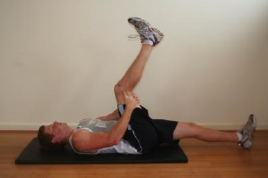
Gastrocnemius Stretch
Keeping knee straight, with toes onto wall or step lean forward to bring knee towards wall. Hold 30 seconds. Repeat 2 times per set.
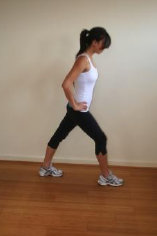
ITB Stretch
Cross leg behind, reach up and across to form a “C” shape. Feel the stretch down the side of the leg and trunk. Hold 30 seconds. Repeat 2 times per set
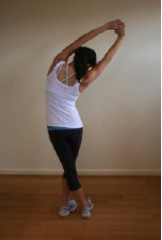
Knee Flexion in Sitting
- Gently bend your knee towards you (you can use a towel to assist this)
- Hold at the comfortable limit of flexion for 5 seconds.
- Straighten your knee slowly
- Continue slowly 10 times.
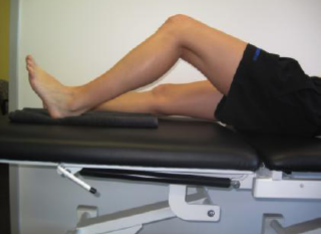
Heel Lifting
- Sit with a rolled up towel under your knee and the thigh rolled outwards slightly.
- Place fingers on inner thigh just above kneecap to feel quadriceps/Vastis medialis muscle contracting.
- Lift heel off bed and tighten quadriceps.
- Hold contraction for 5 secs, rest for a few seconds.
- Repeat 3 x 10 times.
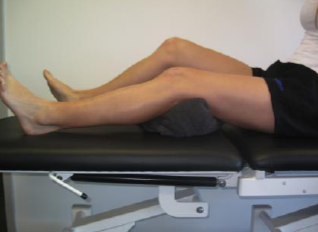
Patella Mobilisation
With knee straight and relaxed, gently move kneecap from side to side
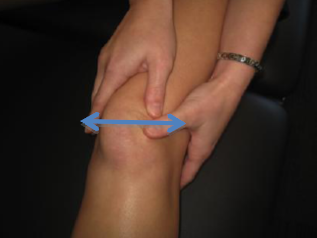
Quad Sets/Extension
- Sit your leg straight.
- Press the back of your knee downwards by tightening the muscle on the front of your thigh.
- Hold for 5 seconds.
- Repeat 3 x 10 time, 6x a day
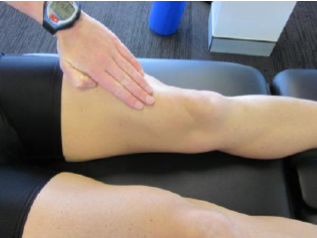
Once you have mastered long sitting progress to:
- Sitting in a chair (pic on left)
- Standing (pic on right)
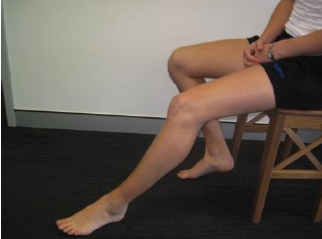
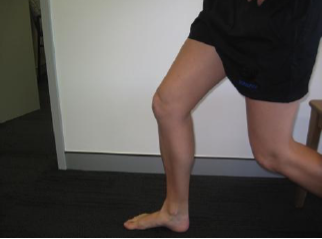
Exercise Bike
As soon as your able start stationary cycling. Start with no resistance gently for 5 minutes
Standing Balance
When COMFORTABLE start standing on one leg Try to maintain your balance for as long as possible up to 30secs
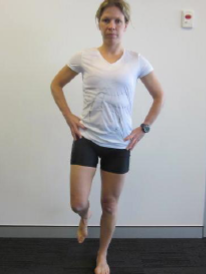
Heel Raises
Stand with weight equally through both legs Without leaning forward rise up onto your toes 2x10reps
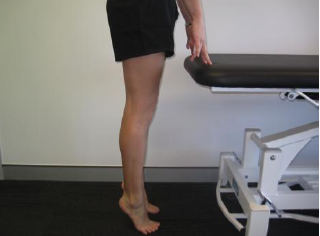
Double Leg Bridging
Once you have regained full movement in your knee and it is no longer swollen (>1 week) begin this exercise Keeping the weight through your heels raise your bottom off the floor. Hold 30s , 3 reps 2 sets
